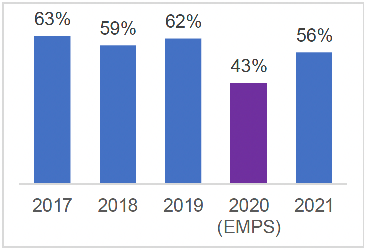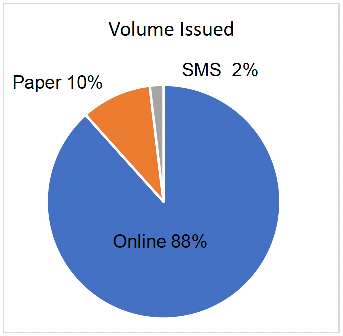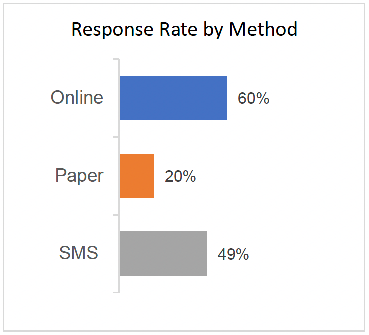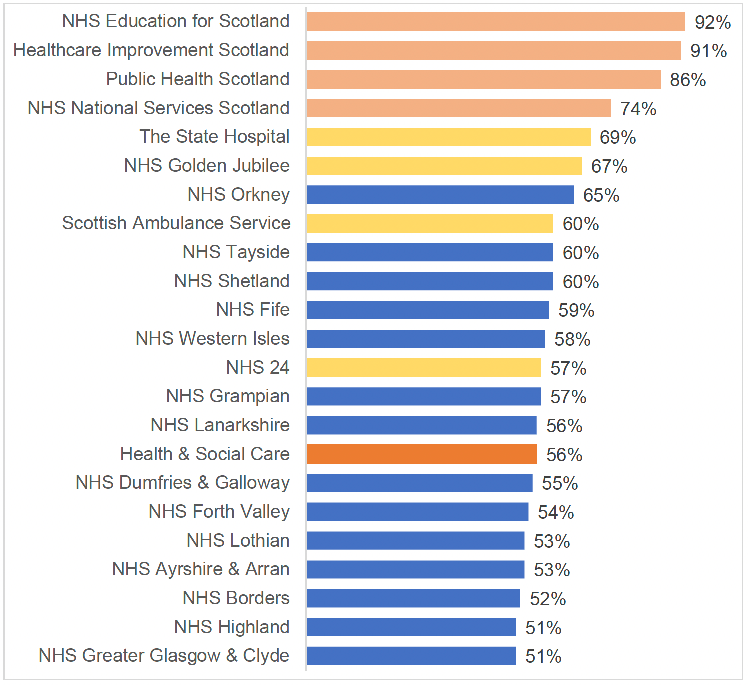Health and social care - staff experience: report 2021
Independent report by Webropol providing detailed information and analysis of staff experience in health and social care across Scotland during 2021.
Response Rates
Overall Response Rate iMatter 2021: 56%
Questionnaires Issued: 194,442
Responses Received: 108,166



Introduction
The response rate shows the number of staff issued with the questionnaire (Recipients) and the number of staff who responded (Respondents) as an overall percentage. The previous response rate requirement of 60% for teams of 5 or more has been removed from 2021. The 100% response rate for teams of 4 or less to generate a report remains a requirement for 2021. This is to ensure anonymity and the higher the response rate, the more realistic the feedback of how staff feel about working in their team. In total 194,442 questionnaires were issued, and 108,166 usable responses were received. This equates to an overall response rate of 56%.
2021 Board Response Rates
While the overall response rate for Health and Social Care for 2021 is 56%, there is considerable variation in response rates across the Boards, ranging from 51% to 92%. The National support boards have the highest response rates, reflective perhaps of the majority of staff's working environment, with easy access to a computer/device to complete the survey on. NHS Orkney has the highest response rate (65%), 5 percentage points (pps) higher than other Geographic Boards that otherwise range from 51% to 60%. All patient-facing National Boards have above average response rates.

Comparing 2021 Response Rates to Previous Years
The table following shows the response rate progression across 2017, 2018, 2019 and 2021. As noted, the overall response rate has declined by 6 pps from 2019, though it is only 3 pps below the 2018 response rate of 59%.
Across individual Boards there is considerable variation in how response rates have changed over time.
Four Boards have achieved a higher response rate in 2021 than they achieved in 2019:
- NHS Education for Scotland up 5 pps to 92%, continuing the improving trend achieved each year
- NHS Western Isles up 2pps from 2019 and up 6pps on the response rate of 52% achieved in both 2017 and 2018
- Scottish Ambulance Service up 1pp from 2019 to 60%, though still below the 64% achieved in 2017 and 2018
- Healthcare Improvement Scotland up 1pp to 91%, continuing the improving trend achieved each year
| Board | 2017 | 2018 | 2019 | 2021 | Response Rate Movement 2021-2019 (pp) |
|---|---|---|---|---|---|
| Health and Social Care | 63% | 59% | 62% | 56% | -6 |
| Golden Jubilee Foundation | 68% | 63% | 67% | 67% | 0 |
| NHS 24 | 67% | 70% | 65% | 57% | -8 |
| Scottish Ambulance Service | 64% | 64% | 59% | 60% | 1 |
| The State Hospital | 78% | 77% | 79% | 69% | -10 |
| Healthcare Improvement Scotland | 80% | 86% | 90% | 91% | 1 |
| National Services Scotland | 76% | 77% | 82% | 74% | -8 |
| NHS Education for Scotland | 81% | 84% | 87% | 92% | 5 |
| Public Health Scotland | 86% | ||||
| NHS Health Scotland | 85% | 91% | 93% | ||
| NHS Ayrshire & Arran | 64% | 59% | 60% | 53% | -7 |
| NHS Borders | 61% | 53% | 53% | 52% | -1 |
| NHS Dumfries & Galloway | 63% | 59% | 66% | 55% | -11 |
| NHS Fife | 62% | 53% | 62% | 59% | -3 |
| NHS Forth Valley | 65% | 62% | 68% | 54% | -14 |
| NHS Grampian | 64% | 60% | 62% | 57% | -5 |
| NHS Greater Glasgow & Clyde | 58% | 54% | 59% | 51% | -8 |
| NHS Highland | 58% | 51% | 60% | 51% | -9 |
| NHS Lanarkshire | 65% | 62% | 65% | 56% | -9 |
| NHS Lothian | 65% | 63% | 63% | 53% | -10 |
| NHS Orkney | 73% | 83% | 66% | 65% | -1 |
| NHS Shetland | 61% | 56% | 63% | 60% | -3 |
| NHS Tayside | 65% | 58% | 61% | 60% | -1 |
| NHS Western Isles | 52% | 52% | 56% | 58% | 2 |
Several Boards have been invited to comment on their response rate achievements:
NHS Western Isles took a supportive, inclusive and empathetic approach to encouraging iMatter participation:
"We took a more proactive approach both prior to the survey as well as during it:
- 1-2-1 support to managers who felt their teams were tired and unlikely to complete this year, equipping them to encourage their staff members around the benefits of completing the survey.
- We were very conscious given the landscape over the last year that we didn't want to push anyone too hard, so took a soft approach to equipping managers in those discussions."
- Support from Comms and IT teams to take over the Desktop backgrounds of all Western Isles PC's and Laptops allowed us to promote iMatter every time someone logged. This was also done in 2019. However, with Covid messages being the dominant visual over the last year on people's desktops, NHS Western Isles were able to capitalise on the opportunity to change focus to something non-Covid related"
Organisational Development & Learning Manager
Scottish Ambulance Service believe that the extent to which iMatter is now embedded within the Service, is key to the response rate achievement:
"We reminded everyone of the relevant dates through CE bulletin but were mindful of how busy SAS was at the time. Directors and their local managers encouraged / supported input and completion of the questionnaire. We were very encouraged to see just how many colleagues had chosen to have their say and acknowledge that this would have been even better had the Service not been so challenged at such an unprecedented time"
HR Manager
Several Boards have seen a decline in response rate from 2019 to 2021 considerably greater than the Health and Social Care average:
- NHS Forth Valley down 14pps from 2019 to 54%, though it is noted that the 2019 response rate was 6pps above 2018. The 2021 response rate is therefore 8pps below the 2018 figure
- NHS Dumfries and Galloway down 11pps to 55%, though only 4pps down on the 2018 response rate of 59%
- NHS Lothian down 10pps to 53%, having been stable at 63% in 2018 and 2019
- The State Hospital down 10pps to 69%
Everyone Matters Pulse Survey 2020
The survey carried out a year ago, while the pandemic was at a critical level, generated an overall response rate of 43%. All Boards have achieved a higher response rate for iMatter 2021 than EMPS 2020. At the time of reporting EMPS, the following reasons were identified for the lower response rate on that survey:
- The COVID-19 situation meant some staff may not have had time or inclination to complete the survey
- There was less opportunity for promotion of the survey, given the compressed timeline and workload pressures
- As the survey results are only being reported to Directorate level there may be a lower level of peer encouragement within teams to take part
Method Effect on Response Rates
In order to ensure all staff have the opportunity to take part in iMatter, paper questionnaires are distributed to those without access to the online survey. The survey is also made available via SMS.
In 2021 88% of surveys were issued online, 10% were on paper and 2% via SMS. The proportion of paper surveys issued has continued to drop from 14% in 2019, 16% in 2018 and 18% in 2017. The share of the responses received is 95% online, 4% paper and 2% SMS.
| Health and Social Care 2021 | Volume issued | % of Volume Issued | Usable Response Volume | % of Responses Received | Response Rate by Method |
|---|---|---|---|---|---|
| Online | 171,801 | 88% | 102,514 | 95% | 60% |
| Paper | 18,965 | 10% | 3,842 | 4% | 20% |
| SMS | 3,676 | 2% | 1,810 | 2% | 49% |
| Total | 194,442 | 108,166 | 56% |
Further details of response volume and response rates by method are contained in Appendix 7.
Summary
Given the unprecedented circumstances that staff and the wider population are living through with the COVID-19 pandemic, it is highly encouraging that over half of Health and Social Care staff completed their iMatter survey and every Board achieved a response rate of over 50%. This gives robust feedback on staff experiences that can be used to inform supportive actions to guide staff out of the pandemic and the return to a future-focused organisation.
Online remains the primary method for iMatter and continues to have the highest response rate. The considerable drop in the paper survey response rate is of concern and suggests some process challenges may exist around the printing, distribution and/or return of paper surveys. Further investigation is recommended as the 2021 paper response rate should be improved in future.
SMS is working well, though still only used by a small minority of staff. Further research among those who have taken part in the SMS survey would be beneficial in potentially developing the option for a larger volume of staff in future.
Contact
Email: Victoria.freeland@gov.scot
There is a problem
Thanks for your feedback